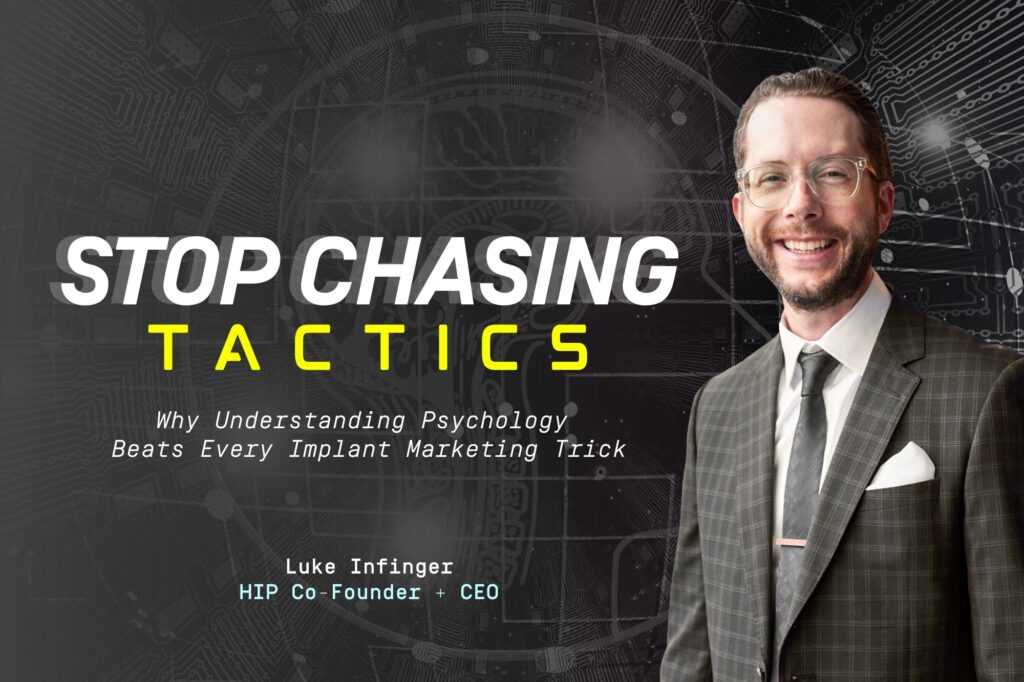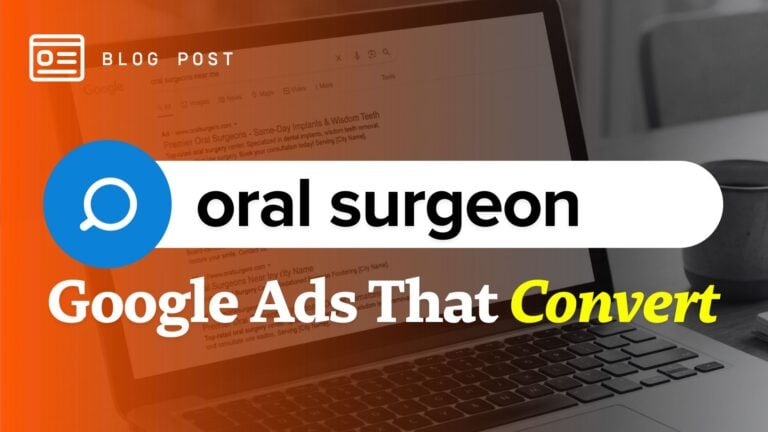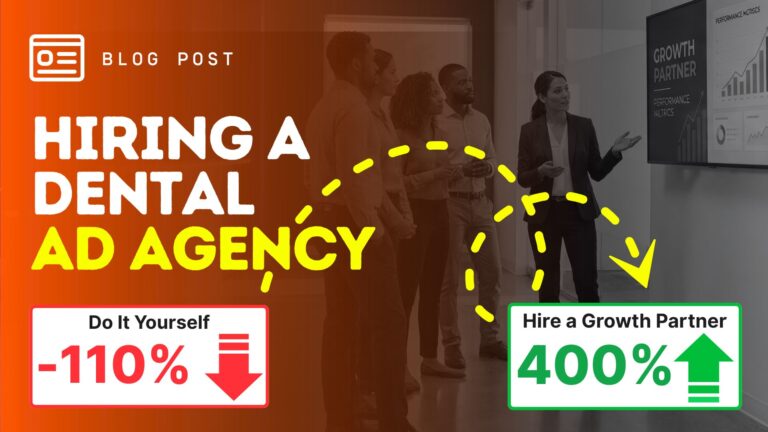Subscribe: RSS
Ever watch a patient nod through your implant presentation then disappear? You’re not alone. Most practices chase the latest marketing tactic while their ideal patients scroll past generic ads that sound like every other dentist in town.
Here’s the truth: You can find a billion marketing companies to push buttons. You can’t find many who understand what makes people buy.
Going from tactical to strategic is the biggest single performance enhancement you can make. It’s the difference between working at 30 % capacity and hitting your full potential. The gap between struggling to fill chairs and turning away patients.
This isn’t about more tactics. This is about understanding the psychology that drives every buying decision your patients make.
The Psychology Foundation: Why Consumer Behavior Trumps Demographics
The Death of Demographic Targeting
Forget everything you know about targeting 45-year-old males in your zip code. Meta’s algorithm has moved beyond basic demographics to something far more powerful: behavior patterns.
Think about it this way. Your typical implant demographic might be working class, lower income patients who’ve neglected dental care. But what about the affluent professional whose teeth weakened due to a medical condition? Traditional targeting would miss him entirely.
The platform now tracks engagement signals that matter more than age or location. It knows who slow-scrolls past dental content, who zooms in on before-and-after photos, who hovers over “schedule consultation” buttons without clicking.
The Three Pillars of Consumer Psychology in Healthcare
Behavior patterns reveal how patients actually research and make decisions. They don’t read your credentials page first. They scan reviews, watch testimonials, and compare multiple options before taking action.
Attitude formation shows their trust levels, skepticism, and past experiences. A patient burned by a previous dentist behaves differently than someone seeking their first implant consultation.
Emotional drivers include fear, aspiration, and social proof. The fear of more tooth loss outweighs the desire for a perfect smile by 10 to 1. Fear drives immediate action. Aspiration creates someday thinking.
The 2025 Patient Reality
Your potential patients are skeptical, impatient, emotionally driven, and overwhelmed. They have shorter attention spans than goldfish. Eight seconds to capture their interest before they scroll away.
Banner blindness and ad fatigue set in faster than ever. Nothing stands out in a sea of generic dental ads promising “gentle care” and “advanced technology.”
Personalization isn’t a bonus anymore. It’s expected. Patients respond to messaging that feels like it speaks directly to their specific situation, not everyone with dental problems.
The Seven Data Categories That Reveal Patient Intent
What Technology Platforms Actually Know About Your Potential Patients
Meta doesn’t just track clicks and likes. It monitors engagement signals like scroll speed, dwell time, and hover patterns. When someone slows down on your video ad but doesn’t click, the platform records that hesitation as interest.
Content interaction mapping builds a web of what health topics they explore repeatedly. Are they researching dental implants, reading about denture problems, or engaging with smile makeover content? This creates a behavioral profile more accurate than any survey.
Purchasing behavior categorizes users as window shoppers, impulse buyers, or researchers. The platform knows if someone typically clicks through immediately or takes weeks to convert after multiple touchpoints.
The Offline Behavior Connection
Here’s where it gets powerful. Digital signals connect to real-world actions through geo-location tracking and phone number matching.
A patient might hover over your implant ad on Instagram, then Google your practice name three days later, then call from your website a week after that. Meta connects all these dots and attributes the phone call back to the original ad interaction.
This is why Google Ads can track “store visits” as a conversion metric. Your phone literally tells the platform when you walked into a business after seeing their ad.
Turning Data Into Targeting Strategy
The platform uses interest and intent modeling in real-time. It constantly updates user profiles based on fresh engagement data, not static demographics from six months ago.
This creates a feedback loop where high-performing ads beat bigger budgets. Relevance trumps spending. A strategic ad that connects emotionally will outperform a generic ad with triple the budget.
Logic vs. Emotion: The Six-Step Framework for Persuasive Messaging
Why Most Dental Marketing Fails
Most practices speak to the rational brain instead of emotional drivers. They flood ads with specs, stats, and features. CBCT scanners, awards, credentials, multi-specialty services.
But that’s not how the brain works. Patients don’t think about your technology first. They think about comfort, trust, pain, worth, and convenience.
Will I feel comfortable here? Is the pain worth the outcome? Can I trust this dentist after being burned before? Is this worth the money? How easy is it to get there? Can I get an appointment this week or wait two months?
The Six-Step Advertising Framework
Step 1: Salt the cut. Intensify the pain of the problem. “Remember when you could eat anything?” hits harder than “We offer implant services.”
Step 2: Show how you can help. Position your solution without overwhelming them with details. “Start your journey back to normal eating.”
Step 3: Prove the solution. Third-party validation through testimonials, reviews, and success stories. Not your credentials, but patient outcomes.
Step 4: Apply the advantage. What makes you different? Not your equipment, but your process. “No rushed five-minute consultation. No pressure guarantee.”
Step 5: Take away risk. Guarantees, free consultations, second opinions. Remove the barriers to taking the first step.
Step 6: The close. Clear call to action with urgency or scarcity. “Schedule your complimentary consultation this week.”
Real-World Application Examples
Compare these approaches:
Emotional: “Three dentists, three different opinions. Who do you trust?”
Logical: “We’re a multi-specialty practice with advanced training.”
Emotional: “The rushed five-minute consultation that leaves you with more questions.”
Logical: “We use the latest CBCT technology for precise treatment planning.”
Emotional: “Remember when you could eat anything?”
Logical: “We offer full arch implant restoration services.”
The emotional versions cut through noise. They speak to real patient experiences and fears.
The Speed-to-Lead Psychology: Why Eight Seconds Changes Everything
The Lead Decay Phenomenon
Your qualification rate drops from 30% to 12% in 60 seconds. That’s not a typo. Harvard Business Review data shows the difference between five minutes and 10 minutes is a 400% decrease in conversion rates.
Lead conversions are 391% higher if you call within a minute. The odds of contacting a lead drop 100 times if you wait 30 minutes instead of five.
Why? Because patients have do-not-disturb settings, short attention spans, and multiple options. They’re researching three other practices while your team finishes lunch.
The Hybrid Follow-Up Psychology
Here’s the reality: 92% of all customer interactions happen over the phone. You can warm them up with text, but the phone call builds rapport and gets them to show up.
The sequence works like this:
- Immediately: Call, leave voicemail, send text
- Two hours later: Call, leave voicemail, send text
- 24 hours later: Call, leave voicemail, send text
Each message references the previous attempt. “Hey Sarah, that was me who just called. This is Luke at Hip Dental regarding your implant consultation request.”
Consumer Behavior Insights for Follow-Up
Most patients never respond on the first contact. They’re researching across multiple platforms, comparing options, and reading reviews before making decisions.
They might see your Facebook ad, visit your website, check your Google reviews, then wait a week before calling. That’s normal buyer behavior, not “bad leads.”
The key is consistent, helpful communication that builds familiarity without being pushy. You’re staying top-of-mind during their research process.
Practical Implementation: From Psychology to Profit
The Three Foundational Tactics That Could Generate $500K+ Annually
Before diving deeper into strategy, fix these three massive revenue leaks:
Missed call tracking and recovery. Dental practices miss 30 to 38% of incoming calls. Almost 80% of missed calls are potential bookings, with 65% being new patients. Every 10 missed new patient calls equals $8,500 in lost revenue for a general dentist. For implant specialists, that number jumps to $25,000 or more.
Reactivation campaigns for dormant treatment plans. You have a goldmine sitting in your practice management software. Patients who received treatment plans but never moved forward. A simple reactivation campaign typically sees 10 to 20% response rates. One large practice pulled in $100,000 from a single campaign.
Show-rate incentives for scheduling teams. No-show rates drop from 25% to 8% when you incentivize your scheduling team for shown appointments. That’s $17,000 additional monthly revenue for a practice doing $90,000 in collections. Annual impact: $150,000 to $200,000.
Building a Psychology-First Marketing System
Start by auditing your current messaging. Are you leading with features or emotions? Are you speaking to the rational brain or the decision-making brain?
Replace demographic targeting with behavior-based assumptions. Instead of “45-year-old males,” target “people who engage with dental restoration content but haven’t scheduled consultations.”
Create immediate response protocols for digital leads. Every minute you wait cuts your conversion rate in half. Set up systems that can respond within 60 seconds, whether through live chat, automated text, or immediate phone calls.
Measuring Psychological Impact
Track engagement signals, not just conversion rates. Are people slowing down on your ads? Are they hovering over call-to-action buttons? Are they sharing your content or saving it for later?
Monitor ad performance feedback loops. Meta will tell you when creative resonates with your audience. High-performing ads earn better placement at lower costs.
Test emotional messaging variations systematically. Run one ad focused on pain avoidance against another focused on outcome achievement. The data will reveal what motivates your specific patient base.
Strategic Thinking as Competitive Advantage
The marketing industry is about to see massive consolidation. AI will eliminate 99% of tactical marketers within three years. The tools are becoming commoditized. Anyone can create ads, run campaigns, and generate reports.
But the 1% who understand psychology will dominate. They’ll know why people buy, how to craft messages that resonate, and how to build systems that convert browsers into patients.
If you can truly help patients, you have a moral obligation to master persuasive communication. The best clinical skills in the world won’t help anyone if patients never discover you or never take action.
Stop chasing the next marketing tactic. Start building psychological understanding into your practice systems. Your patients are waiting for someone who truly gets them. Your competition is still talking about their CBCT scanners.
The choice is yours.



